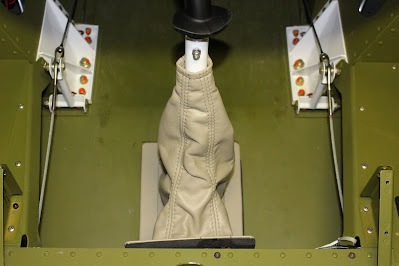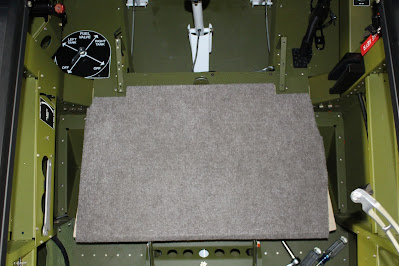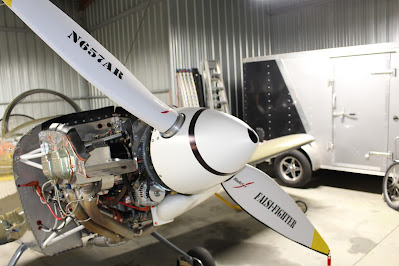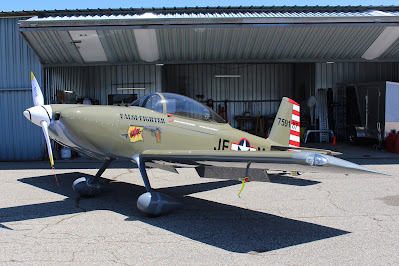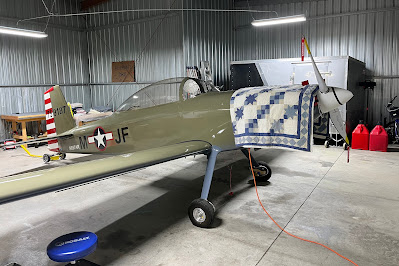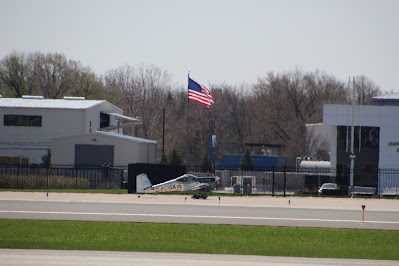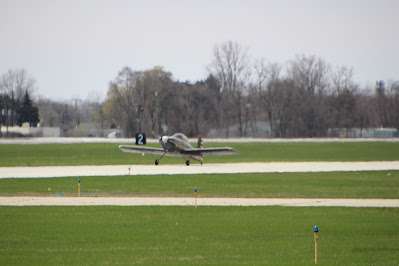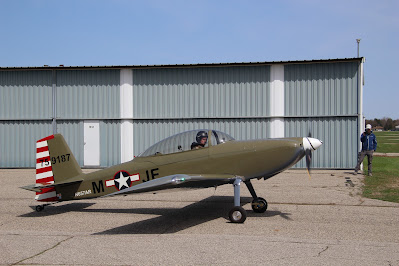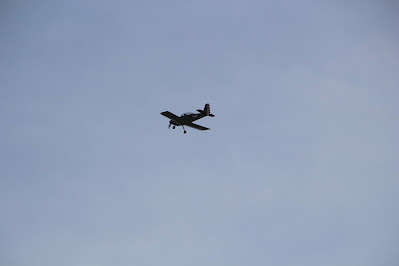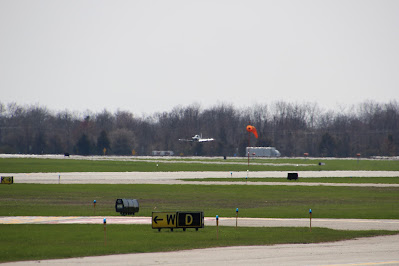April was quite the tumultuous month. Some tremendous highs and devastating lows, and I'm sure that trying to write this entry will follow a similar trajectory. I want to get this published today and check it off my list, so here goes. Wish me luck. (didn't work; published next day)
The final tasks done before the airworthiness inspection included affixing the MI Registration tags onto the tail, recalibrating the flap settings to 20° and sanding and smoothing the wingtip mold seams. I also created a first draft of a comprehensive construction timeline.
The Airworthiness Inspection occurred on Wednesday, March 30, 2022. DAR-F Matthew Tomsheck arrived at 2:00 p.m. We had done a lot of pre-inspection discussion; he had seen my build logs and knew a lot about the airplane and my level of documentation. At the end of our greeting he took a serious tone and stated "Now I want to see ALL of your photos". I stared at him for a second and saw the mischievous gleam in his eye and the grin start to appear on his face. I instantly knew I was in good hands and he got right to work, starting with the firewall forward area. Some notes were taken and refinements made. We did some research on the nav light installation instructions and lack of aileron stops, which were never mentioned in the instructions or on the plans. Overall, he was satisfied and complimentary about the condition of the aircraft. Near the end of the inspection I noted that he had not looked at the installation of the engine monitoring avionics in the forward baggage area. As I went to open the forward baggage door, the key broke off in the lock. The locking mechanism had always been stiff and it had gotten worse with the cold winter temps. I was dreadfully embarrassed but Matt didn't seem concerned. I got the baggage door to open with a screwdriver so he could finish the inspection. From there, we retired to the warmth and comfort of a DCT Aviation debriefing room to go through the paperwork. Before long, the airframe logbook had an airworthiness endorsement and I had the airworthiness certificate. I was surprised to see that it was actually a three-page document, and Matt carefully reviewed the details of the certificate and their significance. We returned to the hangar for the obligatory photo op before Matt departed. I sat down in my chair, breathed a huge sigh of relief and pondered what would come next. I had crossed the finish line of airworthiness. Now I could finally slow down and saunter my way up to the podium of first flight.
The next thing to happen turned out to be another inspection, performed by Carl Franz. Carl is a serial RV builder, a tech counselor with 20 years experience and the recipient of the 2021 Tony Bingelis Award from the EAA. He was doing the inspection on the behest of Terry Lutz; Terry always has Carl inspect a potential test flight aircraft. He and Terry had helped me with canopy work earlier in the build and I welcomed the opportunity to get Carl's evaluation of my airplane. He suggested a few additions to the squawk list started by Matt Tomsheck, and I worked while he inspected. The alternator belt was tightened and the bolt resecured with safety wire. I worked on the forward baggage door lock until it could be reliably actuated with a screwdriver, attended a couple more minor details and laid out notch lines for the canopy rail that would allow easy removal of the canopy. Carl was very complimentary regarding my overall workmanship, which I found very encouraging.
It was time to begin reassembly, but first I had to check the brake lines. The left one still showed signs of seepage at the connector, so it was wiped down and retorqued. I would leave it uncovered for a few days to confirm that the seepage had stopped. The wing inspection covers were reinstalled. I moved on to the cockpit, installing the passenger harnesses. It took a couple tries to get it right, but eventually I moved on to the cockpit side panels, console covers, front stick boot and front seat ramps.
During the cockpit assembly I leveled the fuselage to make it easier to maneuver in the cramped cockpit. I'd used the empennage stand in the past, cobbling together an angled platform for the tail to rest upon. I decided to make a proper jig that could be set on the spar platform of the empennage stand. I got it wrong a few times, but eventually I had something I could just set on the spar platform every time I used the empennage stand to support the tail. I had also used a previously made floor platform as a temporary seat while installing the console covers. It was made to use without the front seat ramp support brackets installed. It had to be modified to fit between the support brackets to prevent damage while in use.
Preflight reassembly continued and more squawks were addressed. Star washers were added underneath the ignition loom screw nuts; the prop spinner backing plate was reinstalled, the ignition leads were sealed into the loom plates and the preheater wiring standoffs were improved with fabric tape wrapped around the pushrod tubes. The oil pressure adjuster was safety wired. The bottom left corner of the aft baggage shelf was notched to accept a grommet for the battery charging cable. With the modification done, the aft baggage area was reassembled.
There came one last preflight inspection by Dave Carrick, the designated test pilot for the first flight. Dave flew in from Canada aboard an RV-7 and cleared customs at PTK before taxiing to the front of my hangar. He inspected my aircraft and made some suggestions for improvements, most of which were implemented immediately. He mentioned that I hadn't set up some of the gauge arcs on the Garmin G3X; I made notes on the missing indications. We discussed the details of the first flight test cards and the logistics involved. When it was time for Dave to depart back to Canada, he spent a long time on hold with ArriveCAN (Canada's border crossing bureaucratic entanglement) before he could launch from PTK and head back to Windsor.

After Dave departed I kept working on reassembly; mounting the prop spinner, modifying the passenger seatback to increase clearance around the canopy latch handle, installing the front seat harnesses and both seatbacks. The crotch straps were installed; additional zip tie points were affixed to secure wiring bundles; the document holder was affixed to the left cockpit skin and the iPod holder was reinstalled. The fuselage reassembly was complete... for now.

Preflight reassembly continued. I reviewed my video of Jason Smith's tutorial and made notes on setting the gauge arcs. I called Carl Franz and Curt Martin to get confirmation on a few details. The entire firewall forward area was carefully examined. A whistle stop hole was drilled into the crankcase vent tube and the edges angled slightly to induce correct airflow. Some additional improvements were made to wiring standoff, routing and protection in the engine compartment. The bottom cowl was reinstalled and consideration given to securing the bottom hinge pins. I filed notches in the edges of the fuselage skins so that the hinge pin handles would be held in place by the slipstream. During this process the jeweler's round file slipped a few times and eventually broke, causing some gouges in the bottom skins. I'll smooth the gouges and touch up the notches and gouges with enamel paint when the hangar is warmer. The top cowl was reinstalled.
For the final assembly of the intersection fairings, the rubber gap seals needed to be installed on the metal fairings. I purchased 3M weatherstrip adhesive and tried using it on the lower empennage fairings, but it wouldn't adhere to the unscuffed clearcoat, so I stopped using it after the first attempt. There was a learning curve for installing the fairings with gap seals, so it got easier with each piece. The upper empennage fairing fit was marginal; I didn't like the way a few of the Tinnerman washers laid on the part, but it was adequate enough for flight. With the empennage fairings assembled, I tried out the pilot's seat with the harnesses fastened, getting the feel of strapping into my plane. I continued with the installation of the wing fairings with gap seals and the upper intersection fairings. Now the preflight assembly was essentially complete.
Even with reassembly complete, there were a lot of other things to try and details to address. I experimented with getting in and out of the back seat; the gauge arc markings were set up on the G3X; the edge of the aft seatback needed more trimming and painting before it was reinstalled.
I wanted to leave the wheel fairings and lower intersection fairings off for the first few flights for a couple reasons: the increased drag would be helpful during engine break-in and I wanted the brakes exposed until I was certain they were functioning properly with no leaks or loose parts. It would be a complete waste of time to reinstall them just to take glamour photos of the finished aircraft, just to take them off again. But I had many days available to waste and there was a good weather window for ramp photos. So on they went, I gave the plane a bath and Falsi-Fighter had her day in the sun.
I had almost forgotten that I still hadn't tried fitting the Bruce's Custom Canopy Cover I had ordered months ago. Before I took it out of its tote bag I checked the fit in the forward baggage compartment and it fit perfectly in the vertical section next to the avionics. It went on easily enough and I was happy with the coverage, but I found myself wanting to modify it to fit around the aft canopy pull knob. It works well enough as is, so I'll leave it that way for now. I got some additional practice with the cover when I brought my daughter to the hangar and let her try out the back seat. She liked it a lot more than her facial expression may have indicated... she's even more of a ham than I yam (sorry, couldn't resist). I had also placed an order from Aircraft Spruce for a pitot cover and some of Bruce's custom RV-8 intake covers, all of which fit perfectly. I fabricated some temporary vent tube plugs out of pipe cleaners, ribbon and a bow which will work for now.
There was a period of a couple weeks when I was waiting for schedules and weather to come together for the first flight, but I managed to stay busy. I was asked by John Maxfield to give a presentation on building my RV-8 at the EAA Chapter 113 general meeting on April 21. A pretty large topic to try to fit into 45 minutes, but I spent a few days collating 344 photos and expanding my previously written build timeline into a proper presentation script. After a few rehearsals I got it to fit into a reasonable time frame. If you're interested in seeing the presentation I captured it on video and edited a special version for my YouTube channel. The first hour is the presentation, followed by a half-hour Q&A session; I'll leave a link below. I won't give anything away, but the first five minutes are worth watching even if you don't watch the whole thing. Here's a teaser photo:

RV-8 Build Presentation 220421
Another important thing that happened while waiting for first flight was getting some recurrency training from Bruce Bohannon. The winds had been high in Texas all month, but Bruce assured me that we could still get it done safely in the two days we had reserved. A spring snowstorm was coming through Michigan on the day I was scheduled to depart. My flight didn't leave until 8:35 p.m. but I headed to DTW in the morning, knowing I'd rather hang out at the airport for hours than risk bad driving conditions and delays caused by the snow. It was a pleasant hang, the time passed well, my flights were on time and I made it to HOU around 1 a.m.
I caught a Lyft to the local Hampton Inn for a few hours of sleep before picking up my rental car. Bad news: my economy car was not available yet. Good news: they put me in a Mustang convertible. Sometimes you just get lucky. I headed to Bruce's Flyin' Tiger Field (81D) and after discussing the flight plan we took off, staying out of the low clouds and headed over to AXH for some pattern work. Although things were going well, I was tired and after nine landings I started to feel task saturation creep up on me. We flew over to LVJ, took a break and discussed our options. Bruce suggested that we fly back to his place; I could get some rest and we could resume flying that afternoon. I knew I'd be worthless even after a nap, so I talked him into an early start the next morning.
We flew back to 81D and I had some time to kill before I could check into the Home2 Suites, so I put the top down and ambled over to Space Center Houston for a look around. The place was packed with school buses and kids and there was a line to buy expensive tickets, so I just took a few photos outside before heading over to Pearland. I parked the car at the hotel but my room wasn't ready yet, so I walked over to Bombshells for a few beers and an early dinner. I settled into a secluded booth and did some bookkeeping, savoring the moment. Later on I would be glad I savored that particular moment.
While I was waiting for my meal I called my brother Dan to wish him a happy birthday. He was doing well, but he did give me my first jolt of bad news for the evening: my brother-in-law had passed away that morning. That changed the mood, and I spent the rest of the evening feeling somber and contemplative. I checked into my room and tried to get some sleep early, but at 11:30 I got a call from Amy and another jolt of bad news that would make sleep impossible. Without going into detail, let's just say that our lives were about to become considerably more complicated and difficult than they'd already been for the past month, and there was no way of knowing if or when the situation would be resolved. I think I may have drifted back to sleep for maybe another hour before my alarm went off. As I headed toward Angleton the scud was even lower than the day before and I drove through rain showers with my mood even grayer than the sky. I was a bit early so I parked nearby and collected my thoughts. If this was a solo flying day, I'd have cancelled. I didn't like the weather and I wouldn't have passed an IMSAFE checklist, flunking out on Stress, Fatigue and Emotions. But I knew I should show up and discuss it with Bruce. Of course when I mentioned the weather he gave me an exasperated look that made me laugh; this stuff was nothing to him. When I mentioned the other factors, he told me he understood completely; I was the boss and I could cancel if I wanted. But he said he knew that I could do this, I needed to learn that I could do this, and he'd have my back. I'd been repeating his mantra "Dig Deep" for the past two days, facing my fears and working through my anxiety. This was just another test that I needed to face, and anyway I wanted to fly, didn't I? Yes, I did. So we went up and went to LVJ first and did 11 circuits... and it may well have been the best flying that I'd ever done. All the lessons I'd learned the day before were keeping me in good shape and with the still-high winds on my nose, the plane flew beautifully. Bruce was impressed by my performance and knew I was up to the challenge, so he directed me back to AXH where we'd have a decent crosswind. I wasn't happy with my first approach and went around; he approved. The next landing was a bit trickier than the others, but really no big deal. We made it a full stop and discussed our options during the taxi back. Bruce said I was welcome to stay and do some more landings here, but he didn't really think they were necessary. As far as he was concerned, I was more than ready to fly my own bird, so I should just go home and do it. So we returned to 81D and it was the first time I approached and landed at his tricky little strip without any assistance. In fact, my landing was better than his had been the day before. So the day ended on a very high note, one that will resonate with me for the rest of my flying days. We did our usual debrief and talked for a bit before I changed into my airline clothes and departed. As I drove down his driveway I realized that I was a different person than the one that had drove up that morning, and that felt pretty good. I had achieved my goals; I was in a Mustang with the top down, I had free time and I had options. On the way out I stopped by MSR Houston the motor speedway resort that I'd been driving by (and flying over) during each visit. I thought I'd maybe do some karting, but the kart track was closed on Wednesdays, so I just checked out their office and explored the facility a bit before heading to the Lone Star Flight Museum in Houston. There were a couple school buses there, but the kids were cool and after they departed I had the place to myself. I did the usual photo recon through the facility before relaxing and just walking around the place, taking the time to examine the displays. Although I probably had heard about it in the recent past, it was still a surprise to see an old friend on display: Bruce's Exxon Flyin' Tiger. I couldn't help bending the ear of one the docents, boasting on how I had just been flying with Bruce that morning. I sent Bruce a text with the same photo I'll share here and the words "Well gee... look what I just happened upon..." Bruce replied, as only he can: "Ain't that some shit?" I laughed and replied "Some really great shit". I eventually returned the rental car and caught my flights home, arriving at 2:30 a.m. and took care of some bookkeeping before going to bed. I'd wake up to a different life than the one I had on my departure; some good, some bad, but I knew I was ready for it all. All I had to do was dig deep.
The evening following my return was when I made my presentation to EAA 113; it would be a couple more days until we were able to set a date for the first flight: April 28. I laid the groundwork for the first flight; speaking with tower and airport personnel and making arrangements for Scooter Stinson to capture video of the takeoffs and landings from the south side. I removed the wheel fairings/lower intersection fairings and improved the security of the brake line loop from the gear leg to the caliper. A Garmin Virb adhesive shoe was affixed to the center edge of the glareshield and I experimented with a few mount configurations. I gave the airplane a through preflight inspection, plugged in the preheater and covered the top cowl with a blanket. She would fly tomorrow, and she was ready.
I had received a phone call from Dave Carrick late that evening. Circumstances beyond his control put our plans in possible jeopardy; he would have to confirm in the morning. I got up early and just before I left for the airport Dave confirmed that the plan was a GO. He would fly from Windsor to Hamilton to pick up Steve Thorne; they would be at PTK by around 11:30. I arrived at the hangar, nervous as a cat on caffeine and pacing about, fiddling with details. At 11:00 I got a distraught text from Amy: another brother-in-law had passed away from a heart attack this morning. Another gut punch. This was getting ridiculous; it was as if God Himself was making sure my family and I would not be able to enjoy this day. Ok Marty, time to dig deep again. Steve and Dave arrived at PTK right on time, cleared customs quickly and taxiied over to my hangar.
They parked in front of my neighbor's hangar and climbed out. Steve unpacked his gear while Dave and I reviewed the test cards for the two flights he planned to make that day. He did his own preflight of the aircraft while Steve and I set up cameras in the fuselage. We pushed the aircraft outside and Dave strapped in, going over systems and discussing plans with Steve. Engine start was at 1:09 p.m.
The engine sounded healthy and happy. Dave did the runup on the hangar ramp before taxiing to the west end of the airport. The prevailing wind dictated using runways 9R/9L; not the ideal direction for taking off on a first flight. The 27 runways would have presented better options for a forced landing, but we had to take what we could get. Dave wanted to use 9R (the longer runway) for a high speed taxi before going back to take off. It was a beautiful morning and the airport was busy. It took a while for him to get clearance but eventually he took the runway, accelerated quickly, raised the tail and reduced power. It happened so fast and that end of the runway was so far away from my position I almost missed the actual taxi; I caught the tail-up portion and watched as he cleared the active and joined taxiway Charlie to return to the end for takeoff.
Another wait for traffic... and then it was time for flight. At 1:32 p.m. April 28, 2022:
AIRBORNE!
AIRBORNE!
Everything looked and sounded fine as she flew past and Dave turned a left crosswind to climb and orbit north of the field at 3500 ft. Then we heard the radio call that gave me yet another jolt: "657AR has an unknown vibration and is returning to the field." I ran to a vantage point where I could see Dave's approach and landing. He declined any assistance; the no-flap landing was uneventful and he returned to the hangar. The plane had only been the air for about five minutes.
We did a quick debrief on the ramp. Dave stated that the aircraft flew beautifully at first, but as he climbed toward 3500 feet and began to accelerate, he heard a loud vibration that occurred at about 140 knots and got worse as speed increased. He immediately aborted the test flight and came back to the airport. Dave wasn't sure where the vibration was coming from, but he thought it might have been behind him. He also said he smelled something burning that may have been electrical, or perhaps engine paint, as no breakers had popped. As we pushed the aircraft back into the hangar, we discussed the likely sources of the vibration: the upper intersection fairings or the canopy skirt. We decowled the engine and inspected the firewall forward area. Everything looked mostly good but there were traces of oil on the bottom cowling. Some of that had come from the dipstick tube, which I discovered had come loose; there was play in the safety wire. Another source of oil drips was around the L fitting for the fuel pump vent. That seemed odd as that was an NPT fitting that had been properly sealed. We discovered the burning smell may have come from the nylon tube that was attached to the fuel pump vent. It had been moved by the turbulence aft of the baffles and the bottom tip had melted onto one of the exhaust pipes. The smell may have also come from some of the Permatex Ultra Black RTV sealant applied to the baffles and engine cases. We cleaned up the oil; I retightened the dipstick tube and secured it with new safety wire while Dave and Steve examined camera footage to try to learn more about the source of the vibration. I borrowed some aluminum tape from Harry Manvel and used it to seal the edges of the upper intersection fairings. There was nothing we could do about the canopy skirt, so Dave discussed a revised test card for the second flight. We put the cowling back on and I took a brief break before Dave climbed back into the cockpit and headed for the runway. Dave had to endure another wait for incoming traffic before being cleared for takeoff. The second takeoff was as smooth as the first.
The second flight proceeded in similar fashion, including the vibration which appeared at precisely 139 knots and grew in amplitude with airspeed until it became unbearable at 160 knots. Dave spoke to us over the radio and described the situation; it was definitely the aft canopy and skirt vibrating. The high speed portions of the test cards were cancelled and Dave slowed it down to do the low speed checks before coming in for a half-flaps landing. This flight lasted about 25 minutes. Less than ideal for engine break-in, but all's well that end's well.
Once Dave climbed out we debriefed in detail. When the vibration occurred he reached around, feeling the canopy and the skirt on either side. It was definitely those parts vibrating and the vibration felt worse the farther back he reached. He stressed that aside from the vibration, it was an excellent airplane. It flew straight and true hands-off without trim and didn't seen to need a rudder trim tab or wedge. The engine seemed happy and it was one slick airframe. Once the vibration problem was solved, it would be an absolute joy to fly... but it shouldn't fly again until a fix is implemented. I knew about the imprecise fit of the canopy skirt, but didn't realize it would create this big of a problem. The contact points of the vibration were plain to see along the perimeter of the skirt, and they provided clues to possible solutions. The easy fix would be installing skirt seals; the hard fix would be reshaping the skirt. In any case, there was nothing more we could do today. I gratefully accepted the congratulations I received from my team and friends, and Dave, Steve and I drank a toast to Falsi-Fighter's first flight. Dave doesn't drink alcohol and they both had to fly home, so Dave sipped his own flavored water, Steve tried Vernor's ginger ale for the first time and I broke open a special bottle of my favorite scotch. It had been years since I'd sipped Dalwhinnie and had purposefully waited until this day to enjoy it again. The guys began packing up for the journey home while I put tools away and cleaned up, pausing now and then to take another small sip. I captured their departure as they headed back to Canada.
After they faded from sight I poured a second (and final) shot, refilled my back drink of Coke, sat down and pondered the day's events. I felt some relief, but no joy yet. Too many bad things had happened today to allow true joy, but I was finally able to relax and eventually enjoy the evening, moment by moment. I set up the camera and posed with the plane for some selfies. When my drinks were empty I did one of my favorite things... I hung out at the airport, watching planes come and go; occasionally looking over my shoulder to see my airplane sitting in my hangar. I remained there until long after the sun set. Eventually I returned home with the bottle to drink another toast with Amy, combining our congratulations and our condolences. There would be no first flight for me tomorrow, but that will have to be ok. I'll just get back to work again.
What a weird, happy, sad, scary, thrilling, disappointing, wonderful day.
So that brings us up to date, and up to the podium. More of a stagger than a saunter, but I made it. In the past few days I've made the appropriate announcements through various forms of social media, done a lot of bookkeeping and gotten this blog written. I've gotten a lot of positive feedback and helpful suggestions from my aviation community and I'm formulating my plans for solving the issue. Prior to the first flight I wasn't sure I'd have to say this... but now I guess it's inevitable. We'll all just have to Stay Tuned!

































